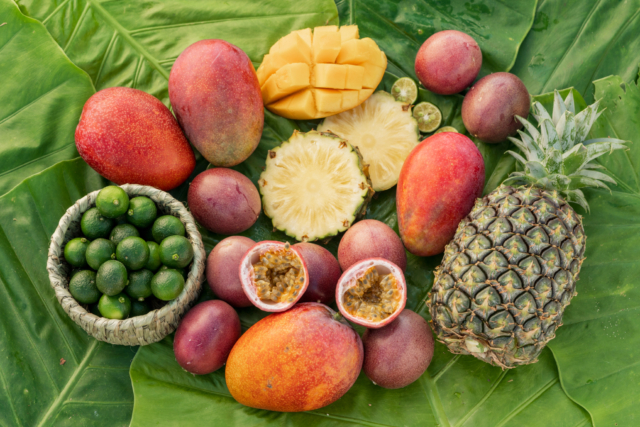生産者さんから美味しい野菜が、生活者やシェフの手に直接届く流れを生み出す。
Together we are creating a flow of good produce directly from farmer to consumer and chef.

ファーマーズマーケットは、毎週末に青山の国連大学前に集まる生産者、消費者、シェフのコミュニティです。今回のコロナウイルスの影響でファーマーズマーケットを休まざるを得ない状況になったことは、「生活を支えるライフラインとして」10年以上にわたって開催を続けてきた私たちにとっても非常に大きな出来事でした。
しかし、この期間にもコミュニティは絶えることなく、生産者さんと直接に連絡を取り合い、お野菜を購入したり、人を紹介したり、お互いを助け合えている状況が生まれていたのは私たちにとって大きな励みでした。
The spread of COVID-19 has made us close the market which has served the lifeline for the city for ten years. However, this critical situation has also made us realise that our community is strong enough to keep connected and help each other.
Now that we find the importance in creating and strengthening community as well as in hosting the weekly market, we would like to enable the community of farmers, consumers and chefs to connect beyond the UNU location, and invite people from around Japan to join as well.
よい食材や、関係性、知識の流れはどのように生み出すことができるだろうか?
How do we create a flow of good produce, relationships and knowledge?

オンラインのプラットフォームを通して、このような流れをつくっていきたいと考えています。プラットフォームでは、オンラインで生産者さんの商品を事前購入し、近隣のピックアップ場所で商品を受け取ることができます。
Our wish is to make an online platform that can facilitate this flow. The basic idea of the platform is: order farmers produce online and pick it up at a location in your local area.
このプラットフォームを成長させていくために、いくつかの場所で実験的に取り組みをスタートさせます。まずは、表参道のCOMMUNEがピックアップ場所となります。
As a starting point, to develop this online platform, we want to test different communal pick up locations. The first one will be at COMMUNE, in Omotesando.
*一部出店者さんの商品は、COMMUNE内にある常設Farmers Marketでも毎日購入できます!
COMMUNE also has a smaller farmers market, where you can buy produce from some farmers and greengrocers every day.
HOW IT WORKS 仕組み
Farmers Marketの公式オンラインストアで注文することができます。
 ⒈「CATEGORY」からピックアップを希望する場所と日程を選ぶ
⒈「CATEGORY」からピックアップを希望する場所と日程を選ぶ
Choose a location and date for pick up.
⒉希望の商品を選び、受付〆切までに注文する
Order before the deadline.
⒊選んだ日時・場所で、注文した商品を受け取る
Pick up the produce at the selected location.

*2020年5月15日現在、ピックアップ場所は表参道駅周辺のCOMMUNEと駒澤大学駅周辺のBrooklyn Ribbon Friesです。今後さらに増える予定です!
As of 15 May, 2020, COMMUNE in Omotesando andBrooklyn Ribbon Fries are the pick up locations. We are working to test at even more locations!
*産地から都内への送料負担を軽減するため、共同購入の仕組みを取っています。毎週木曜日の10時までにご注文いただくと、その週末の土曜日12〜15時(場所によって異なる可能性あり)に商品を受け取っていただけます。
Order by 10:00 a.m. on Thursday to pick up at 12:00-15:00 (may vary depending on location) on Saturday.
*お受け取りの際にはマイバッグをご用意ください。万が一忘れてしまったお客様にはリユースの紙袋/トートバッグをお渡ししますので、次回ご購入時にお返しください。
Bring your own bag when picking up your order. We also have a limited number of paper/cloth bags for you to borrow and bring back later.
DID YOU KNOW? なぜ、生産者との直接の関係が大切なのか?
食卓にたどり着くまでの、食べものの旅路 How much does food travel before arriving at our table?
日本の食料自給率は、カロリーベースでわずか37%。多くの食品を海外からの輸入に頼っています。
フードマイレージという、食料の総輸送量と距離をかけた指標で表すと、なんと約9000億t・km!これは、人口が日本の2倍のアメリカのフードマイル値の3倍以上です。
Food mileage is calculated by multiplying the transportation distance with the volume of food transported. The higher the food mileage the larger the load placed on the global environment. Japan’s index in 2001 was 900 billion ton-kilometres, more than three times that of the United States, which has more than twice Japan’s population.
ロスになってしまう食べもの How much food is wasted in Japan?
日本の食品ロスは年間612万トン。そのうち、328万トンは消費者に届く前の段階で廃棄されています。これは、東京に暮らす人々が1年間に消費する食べ物の量とほぼ同量だと言われています。
In Japan, 6.12 million tonnes of food are wasted annually. 3.28 million tonnes of the food waste are produced by food suppliers. This could feed the entire population of Tokyo for one year!
従来の食のサプライチェーンでは、野菜は生産者から農協などの団体、卸売市場、量販店または小売店、と、生活者の私たちの食卓に届くまでに様々な場所を通ってきます。
卸売や小売の段階でのロス、さらには生産者のもとでも「規格外」などの理由で出荷さえされない野菜などがロスになってしまっています。
In the conventional food supply chain, vegetables are sent from a producer to a farmers’ cooperative, wholesale markets, mass and/or small retailers before consumers receive them.
Vegetables are wasted in the wholesale and retailers’ sides as well as at production, because they are out of the market standard in size and shape.
農家さんの課題 What challenges are Japanese farmers facing?
農林水産省の調査によると、野菜の小売価格のうち、各流通経費等の占める割合は52.5%。つまり、私たちが野菜に支払う価格のうち、農家さんの収入になるのは半分以下です。
また、日本の農業従事者の平均年齢は66.8歳(65歳以上の方が69.7%)です。
(出典:農林水産省 食品流通段階別価格形成調査/農林水産基本データ集)
Of the retail price of vegetables, distribution costs account to 52.5% on average. This means that less than half of the price we pay for vegetables at supermarkets actually goes to the producer.
Also, the average age of farmers in Japan is 66.8, and about 70% of Japanese farmers are over 65 years old.

INSPIRATION AND COLLABORATION
青山ファーマーズマーケットでピックアップ&共同購入の取り組みは、日本の生協運動やアメリカ発のCSA(Community Supported Agriculture)、スウェーデン発のオンラインプラットフォーム「Local Food Nodes」からヒントを得ています。
Local Food Nodes(ローカル・フード・ノード)は、生産者と生活者を直接つないでローカルな食のサプライチェーンを生み出すプラットフォームで、自身も農家であるAlbin Ponnert氏によって設立されました。
青山ファーマーズマーケットでは、ローカル・フード・ノードと情報や意見の交換を行っています。新たな食の流通の仕組みを作り出すのが、地域に限らず世界規模で重視されている今、こうして海外で行動を起こしているチームと連携できることに感謝しています。
There are many interesting initiatives offering different ways of purchasing food produce. We are inspired by the Japanese cooperative movement, American CSA and the Swedish platform Local food nodes.
Local Food Nodes is an online platform hosting local food supply with direct connection between consumer and farmer. It was founded by Albin Ponnert, a Swedish farmer, based on his own experience as well as conversations with farmers across Sweden.
Aoyama Farmers Market is exchanging knowledge and ideas with Local Food Nodes. Creating an alternative to the conventional food supply chain is of local importance as well as global relevance – which is why we are grateful to engage with sparring partners from overseas.

2020.5.12






